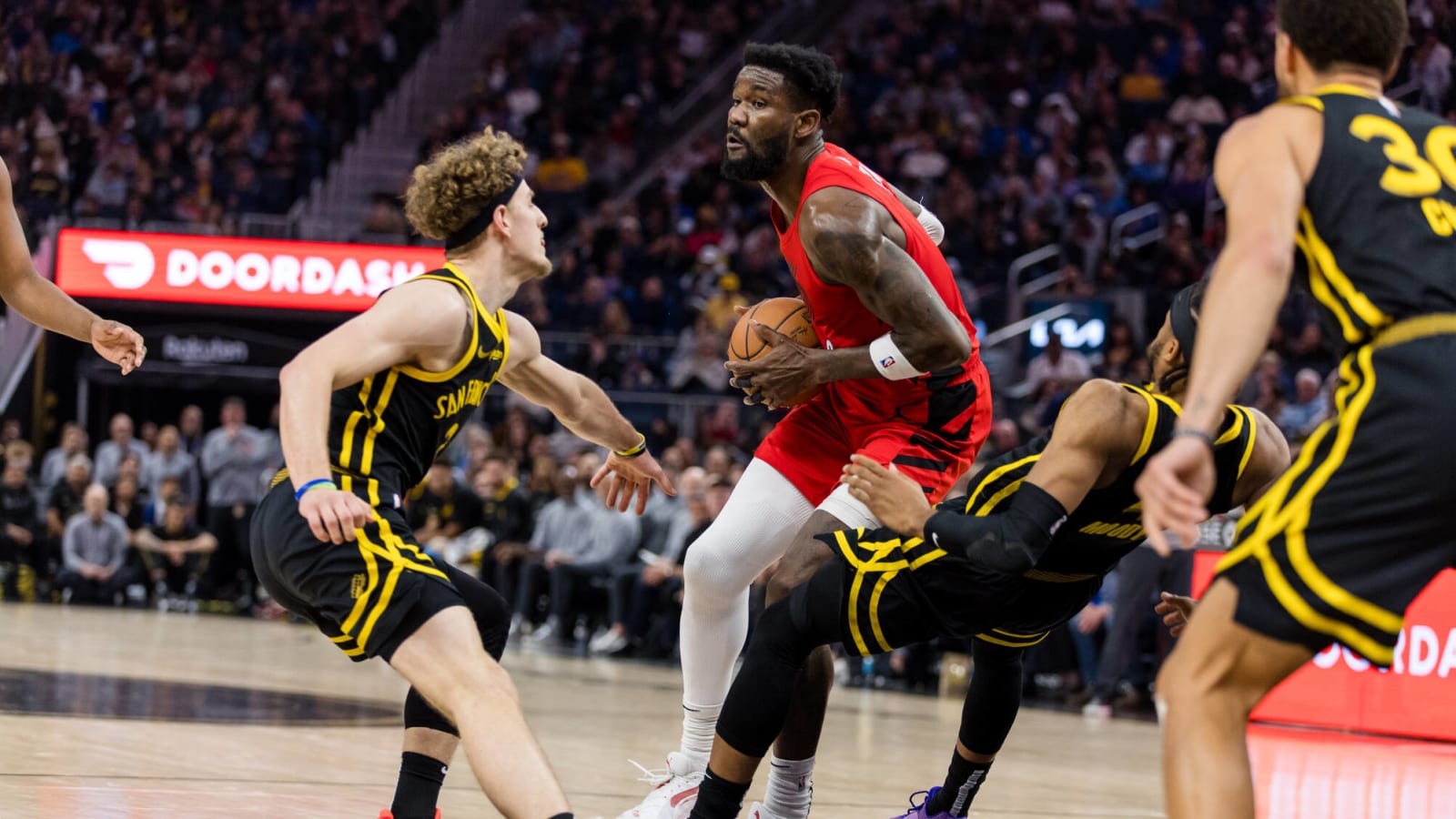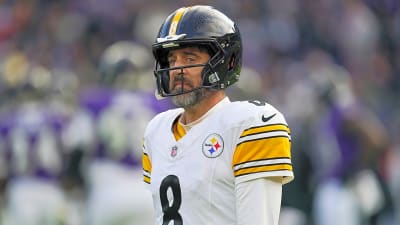
Let’s lay all the cards down: Deandre Ayton is Portland’s most important Trail Blazer.
No that statement is not hyperbole. Yes, it’s a position that goes against the current narrative surrounding the mercurial center’s career. A career bridled by injury, icestorms and inconsistent play. Most would describe this opinion on Deandre Ayton, the starting center for the Portland Trail Blazers, with the word contentious. And yet there is no better characterization for his time in Portland: important.
There’s an argument that rookie point guard Scoot Henderson, or even young phenom, Shaedon Sharpe qualify as more important. But that would belie their potential, which has shone infrequently thus far.
Some might argue Anfernee Simons, arguably the Blazers’ best player from a statistical stand point, more important. However, this opinion is handcuffed to that same potential of Henderson and Sharpe. If those two prove more synergistic, Simons might be playing for a new team before the 2025-26 NBA season.
There’s also a temptation to roll the eyes from Ayton’s statistics alone, down nearly across board excepting steals and turnovers.
But as with all things basketball, statistics are nothing without context. Context also condensed into statistics (truly, a narrative finger trap). Therefore let’s bring in the context numbers.
Statistics of Context
Of Ayton’s current teammates, only five have played major minutes together last season. They are Simons, Sharpe, Jerami Grant, Matisse Thybulle and Jabari Walker. And that’s being generous to Walker. Of those five, Simons is the longest tenured Trail Blazer, drafted in 2018. He is the last remnant of Portland’s most successful season of the last twenty years and the first Western Conference appearance since, well, yeah1.
Compounding how much of project the current roster is, Portland’s average age is 24. Of those signed to real NBA contracts, five are rookies; Scoot Henderson, Kris Murray, Toumani Camara, Rayan Rupert and Duop Reath. Expand it to two-way contracts and Ibou Badji also falls into this category.
Expand it to second-year players and the number rises to nine with Sharpe, Walker, Ashton Hagans and Justin Minaya. That’s nine guys still trying to figure out a rhythm within the league beyond just fighting for minutes. The team is so young, it’s no wonder they have no idea what to do on the court, much less forget to feed the big man.
While Ayton has struggled with some unfortunate injuries, they have been the thief of joy for Portland’s. The amount of player games lost, 220, is second only to Memphis’ catastrophic 377. And yet, the real numer of choice is 482.
That’s how many lineups the Blazers have trotted out for the 23-24 season, tallying at eighth among the entire league. Here’s the full tally before any game was played on March 8, 2024.
While statistical noise certainly exists vis-à-vis coaching decisions2 and sheer talent3, the basic premise of the list holds true. None of the best teams, the contenders, exist on this list. The teams that have a shot at the title do not much struggle with guys in-and-out of the lineup beyond the freak injury.
The level of chaos inherent to the situations of Portland, Toronto, Brooklyn, Memphis and Detroit disrupts the gameplan and disquiets conventions surrounding roles, rotations, touches and tasks. Therefore, if Ayton’s counting statistics and performances seem inconsistent, it’s largely because the lineups have been inconsistent.
But Why Deandre Ayton?
None of this context takes away the known issue: Ayton’s motor is inconsistent.
He’s due to have a poor shooting game game for roughly every five with the uncanny regularity of clockwork. And yet, there are ways to mitigate this occurrence. Firstly, keep him engaged on the court. Secondly, do not, under any circumstance, publicly throw him under the bus. As the Blazers begin to succeed in these endeavors they will begin to see Ayton’s importance.
That importance hinges on three factors. One, he’s a young center proven to anchor a championship core. Two, he actually provides stability on the court for Portland’s youth. Three, letting go of Ayton means Portland will be searching for a center as competent as (if not better than) Ayton.
Young, Fun and No Longer a Phoenix Sun
To address this point-by-point, it starts with the youth factor. Ayton is twenty-five years old, and yet he’s been the bellwether for a franchise with champion aspirations three years running. A cursory look at the advanced statistics showcases just how well he slots into this barometer role.
In his time with Phoenix, Ayton remained the key for every deep playoff run. He anchored a contender-level core for roughly three seasons. Glowingly, he ranked top four in offensive, defensive and total winshares among his team. Even more glowingly, he ranked second in winshares per 48 minutes during Phoenix’s two most successul seasons.
Ayton proved critical to Phoenix’s defensive prowess, for their ability to find points both in the paint and the midrange. His last season in Phoenix, while contentious, saw him continue to provide a similar value of defensive win shares.
Cause for concern comes in the form of decreasing offensive winshares. However, it should be noted that the reduction in 2021-2022 saw him play only 58 games. Ayton’s value over replacement player only increased in tandem with his usage rate. His increased usage rate only came at the expense of Chris Paul’s deteriorating play due to age.
It’s particularly that last point as to why Ayton performances became a bellwether to their season-long performance. Paul certainly played the part as the engine that made the team tick. But it was Ayton who provided the readings on chemistry, that magical element that transforms competent teams into contenders. The case for him being the scapegoat consisted entirely because he became the barometer for Phoenix’s cohesion both on and off the court.
When his role and important are questioned during contract talks in the offseason, Ayton responded by attempting to prove that he was, in fact, worth all of the money. And yet, he was far from the only reason why the 2022-23 Suns devolved from favorites to darkhorse. Injuries, age and a midseason trade for Kevin Durant all pointed to a team in flux. Much like his current one, but with more talent surrounding him.
Go North by Northwest, Young Man
This brings the argument to its second point: a happy Ayton provides stability on both sides of the ball for the Blazers’ youth.
It’s true that Ayton’s offensive and defensive box plus-minus show massive decreases from this last season to the present. It’s true that he is a net negative. But just barely. Although box plus minus is traditionally used to cite individual player impact on offense and defense, the statistic skews towards specialists who play limited minutes and make an abundance of plays.
For example, Matisse Thybulle currently holds the highest DBPM for Portland at +3.3. However, he also gives up -3.0 on the OBPM, neutering his brilliant defensive play to a net neutral. Play him longer minutes and his offensive liabilities will likely be exposed and his defensive impact limited.
Moreover, defensive statistics are still rife with statistical noise, no matter how much a statistician tries to account for it. Once again, defense is a team effort, whereas offense can be generated off the talent of a single player.6 Defense is a matter of scheme, and head coach Chauncey Billups’ scheme continually pulls Ayton out of the paint with regular switches. This leaves the guards to man the paint with Ayton out of position.
He cannot be the answer to every breakdown on either side of the ball. He does, however, provide an important safety valve.
The eye-test suggests that the Blazers are much more connected on offense and defense when Ayton resides in the paint. Every Blazer win with Ayton in the rotation has seen him score in double digits and pull down at least six boards. Ayton also has the package of natural lateral quickness and raw strength to switch when needed.
During the Blazers’ February 27th matchup against the Miami Heat, Ayton locked down the paint en route to Portland’s ten-point halftime lead. That lateral quickness showcased itself in one particular play. Ayton picked up Jimmy Butler at the top of the key, sealed him off at the baseline and then stuffed a paltry attempt at escape.
Ayton followed it up offensively. His teammates continually found him for points at the top of the key or in the paint for midrange swish after midrange swish. When Kevin Love attempted a dangerous, undercutting charge, it left Ayton with a sprained wrist. He would leave the game and a nascent monster statline at the half: 12 points on 6-9 shooting, 10 rebounds, two assists, two steals and a block.
Haste inclines to say that Ayton’s presence provided the keys to winning the game. Measure reasons that Ayton’s contribution provided a winning effort regardless of outcome.
His capabilities were enough to stabilize a patchwork guard rotation and an inconsistent young forward corps for a half7. He’s not so much a backbone, a baseline or a measuring stick for these young saplings as he is a young Douglas Fir, sturdy but still growing. One able to start spreading his roots and provide soil stability from which Portland’s garden can root and grow.
Before Miami, the last 15 games showed sustained growth of the Deandre Ayton that everyone dreams of when they acquire him.
Although the sample size is small, it does encourage two thoughts. A greater familiarity with his teammates and a more defined role on the offensive end. When he returned against the Toronto Raptors on March 9th, Ayton picked right where he left off. He finished with 30 points, 19 rebounds, two steals, an assist and a block on 14-25 shooting. Monster statline complete.
All-in-all his play has trended more towards his middle years in Phoenix, when his advanced stats showcased a player who, more or less, indicated the power inherent to the Suns’ roster before trading for Kevin Durant.
Trade Offs, You’re Talking About Trade Offs?
Writing of such trades, that segues naturally into the third and most crucial factor.
Trading Ayton will leave the Blazers in the same position as they were before Ayton. Searching for a center of commensurate or greater value. After three years of a post-injury Jusuf Nurkic, this is precisely the situation Portland does not need again.
Ayton not only plays a position of value that far exceeds the countless young scoring guards that Portland has peddled in the past dozen years, but separates himself in importance by those first two governing factors already discussed. Simply put, the ages of teammates Jerami Grant and Malcolm Brodgon suggest an inevitable separation through the trade market.
In the case of Grant, it might not even be next season. Not unless Portland drafts French bigman Alexandre Sarr from the Australian NBL or forward Cody Williams from the University of Colorado. If this does does occur, Grant will certainly become a prime candidate for trades by 2025-2026. Brogdon, meanwhile, has been a prime candidate since arrival. This will not change unless the Blazers decide to drastically change tack and trade Anfernee Simons in the offseason.8
Ayton, however, exists with five years left on the better side of age 30. Should he continue to improve each year in Portland, he will attract a raise. His upper limit will probably sit somewhere around $40M AAV. Something not quite so damnable, even in the context of a new CBA and a salary cap that has exploded since 2011.
It might seem foolish, and a lower pricetag would be a favorable coup, but the alternative of simply letting the big man walk for nothing would be downright criminal asset management. The last time the Blazers front office did so, they let perennial All-Star LaMarcus Aldridge walk out the door with their contention hopes in tow. The move completely changed the career trajectory of their last phenom point guard, Damian Lillard, and is half the reason why he never had a real shot at the Larry O’Brien trophy in a Portland jersey.9
Cronin would be wise to avoid such a scenario with his corps of promising young guards. Keeping the young, still promising big who can expand Portland’s offensive repertoire and provide paint stability on defense is paramount.
One can argue that something might change in the future. That the Blazers will find a better fit at this pivotal position within five years. But who are the alternatives?
Considering that four of the best centers in league, Nikola Jokic, Anthony Davis, Rudy Gobert and Joel Embiid are all currently off-limits, that leaves contemporaries Jarrett Allen and Nic Claxton available for discussion. Ayton has a far more complete offensive package than both and provides similar value on the defensive end.
In the draft, Alexandre Sarr has potential, but is not even an NBA player yet, much less a Trail Blazer. The next best prospects, Donovan Clingan, Kyle Filipowski, Yves Missi and Kel’el Ware all project as mid-lottery, a turkeyshoot. The Blazers currently have Badji, but he still has leagues upon leagues of work to do before he’s even remotely playable as a backup.
As it stands, all signs point towards Ayton for the next five years. This is not such a bad place to be. Outside of the human cheat code that is Victor Wembanyama for the Spurs, the Blazers have the roster framework best poised for adding talent and naturally improving among all of the basement-dwellers.
And that, along with his youth, capability and stability, is why Ayton, once the most important player on a contending core for Phoenix, is now Portland’s most important Trail Blazer for the foreseeable future (until proven otherwise).
1 You really want me to say it, huh? 1999-2000. No, I don’t want to talk about it. Yes, I’m still not over it. If the NBA could refrain from the replay, I would be grateful. But they do not. Every. Single. Time.
2 New York, despite a slew of injuries does not touch this list due to Tom Thibodeau’s hard-nosed approach to a limited rotation. Similarly, many of the winningest teams in the league for the season have not drifted above 300 lineups.
3 Dallas, Phoenix and New Orleans are currently engaged in a three way race for the fifth and sixth seed. The former two largely rely on the power of stars Luka Doncic and Kyrie Irving and Devin Booker, Kevin Durant and Bradley Beal, whereas the Pelicans employ an absurd wellspring of youth and depth.
4 Estimated number of wins provided by a player divided by 48 minutes. League average WS/48 is 0.100. To learn more about how Win Shares are calculated, BasketballReference provides a detailed explanation here. Be warned, it is just as nerdy as it is wordy.
5 Cleaning the Glass cites a different number for Usage% at 17.0%—it is unclear, why these two numbers are different; but Basketball Reference generally cites the NBA for statistics, and is thus the measurement used here.
6 I am going to commit a cardinal sin in statistics and forgo the numbers; I watched Damian Lillard play for almost a decade. By the middle of his Portland tenure, he was an offense unto himself. How Adrian Griffin failed to comprehend that he had the basketball equivalent of a tactical nuclear warhead, I still cannot fathom.
7 The Blazers played the game without Henderson, Sharpe or Brogdon and relied on Camara, Murray and Walker to round out their forward rotation. All promising young roleplayers, but still not yet totally reliable.
8 For the record, I am firmly in this camp. I would sooner pull the band-aid off on the eye-test bet that Simons does not fit well stylistically with any of Henderson, Sharpe or Brogdon and needs a team where he can be the undisputed lead guard. Not best player, mind you, just the lead guard.
9 For the other reason, see footnote 6. Ah, what the heck, I’ll give it to you anyways: he’s a walking tactical nuclear warhead. Thankfully, Doc Rivers understands this and now runs plays for him eerily familiar to his time in Portland. Huh, who would have thought that he could be so effective if you design an offense for him.
More must-reads:
- Adam Silver's Las Vegas experiment with NBA Cup may be ending
- Cooper Flagg tops LeBron James with record-breaking performance
- The 'Active NBA PPG leaders' quiz
Breaking News
Trending News
Customize Your Newsletter
 +
+
Get the latest news and rumors, customized to your favorite sports and teams. Emailed daily. Always free!








